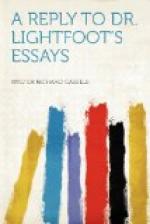As myths lose their might and their influence when discovered to be baseless, the power of supernatural Christianity will doubtless pass away, but the effect of the revolution must not be exaggerated, although it cannot here be fully discussed. If the pictures which have filled for so long the horizon of the Future must vanish, no hideous blank can rightly be maintained in their place. We should clearly distinguish between what we know and know not, but as carefully abstain from characterising that which we know not as if it were really known to us. That mysterious Unknown or Unknowable is no cruel darkness, but simply an impenetrable distance into which we are impotent to glance, but which excludes no legitimate speculation and forbids no reasonable hope.
[ENDNOTES]
[1:1] Originally published in the Fortnightly Review, January 1, 1875.
[4:1] On the Canon, p. 65.
[4:2] Ibid. p. 61, note 2.
[4:3] At the end of this note Dr. Westcott adds, “Indeed, from the similar mode of introducing the story of the vine, which is afterwards referred to Papias, it is reasonable to conjecture that this interpretation is one from Papias’ Exposition.”
[4:4] Reliq. Sacrae, i. p. 10 f.
[4:5] Lehre Pers. Christ, i. p. 217 f., Anm. 56, p. 218, Anm, 62.
[5:1] Theol. Jahrb. 1845, p. 593, Anm. 2; cf. 1847, p. 160, Anm. 1.
[5:2] Synops. Evang., Proleg. xxxi.
[5:3] Komm. Ev. des Johannes, p. 6 f.
[5:4] Die Zeugn. Ev. Joh. p. 116 f.
[5:5] Basilides, p. 110 f.
[5:6] Zeitschr. fuer wiss. Theol. 1867, p. 186, Anm. 1, 1868, p. 219, Anm. 4; cf. 1865, p. 334 f., “Die Evangelien,” p. 339, Anm. 4.
[6:1] Der Johann. Ursprung des viert. Evang. 1874, p. 72.
[6:2] Th. Stud. u. Krit. 1866, p. 674.
[6:3] Intro. N.T. ii. p. 424 f.
[6:4] Ibid. ii. p. 372.
[8:1] The work was all printed, and I could only reprint the sheet with such alterations as could be made by omissions and changes at the part itself.
[8:2] Dr. Lightfoot makes use of my second edition.
[9:1] Contemporary Review, December, p. 4, n. 1; Essays on S.R. p. 4, n. 4.
[9:2] Professor Hofstede de Groot, in advancing this passage after the example of Tischendorf, carefully distinguishes the words which he introduces, referring it to the presbyters, by placing them within brackets.
[10:1] S.R. ii. p. 231 f.
[10:2] Contemporary Review, December, p. 5 f.; Essays on S.R. p. 7.
[10:3] S.R. ii. 228 ff.
[11:1] Wann wurden, u.s.w., p. 73 f.
[11:2] The translation in Scholten’s work is substantially the same as Tischendorf’s, except that he has “promises” for “has promised,” which is of no importance. Upon this, however, Scholten argues that Celsus is treated as a contemporary.




